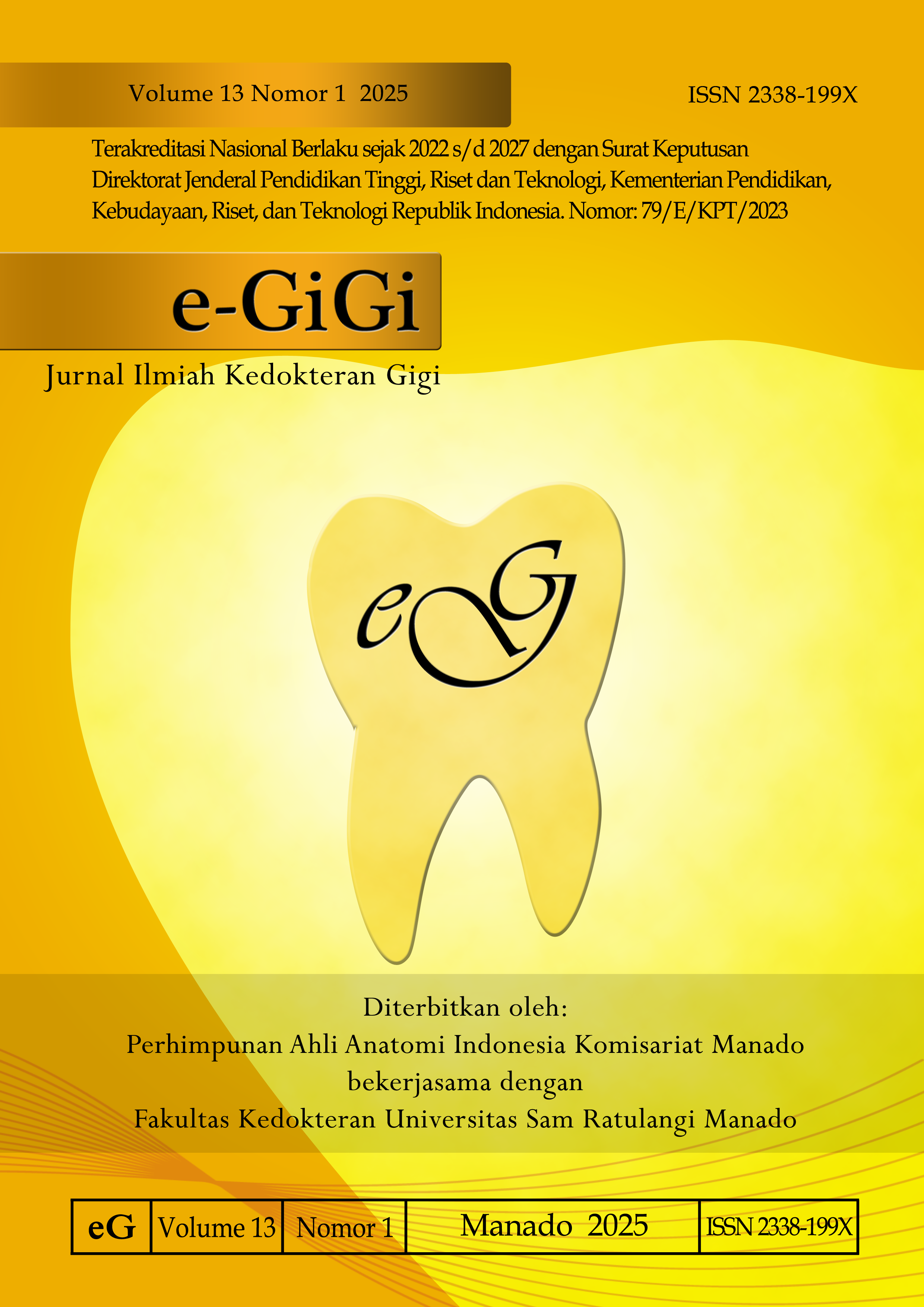Hubungan Estetika Senyum dengan Persepsi Diri pada Mahasiswa Fakultas Kedokteran Gigi
DOI:
https://doi.org/10.35790/eg.v13i1.55669Abstract
Abstract: As the field of orthodontics develops progressively, many patients undergo orthodontic treatment to improve their dentofacial characteristics, which support the facial appearance and aesthetics of their smile. An individual who has unesthetic smile and tooth arrangement is considered to lack self-confidence and have a negative effect, especially on his/her social relationship, education, and career. This study aimed to determine the relationship between smile aesthetics and self-perception. This was a descriptive and analytical study with a purposive sampling design. Samples were students of Faculty of Dentistry Universitas Muslim Indonesia. The relationships between intercommisural distance at midline (mm) and self-perception, and between intercommisural distance (mm) and self-perception were tested using the Pearson correlation test. The results showed that based on the Pearson test, the relationship between intervermillion distance in the midline (mm) and self-perception had a p-value of 0.708, meanwhile the relationship between intercommission distance (mm) and self-perception had a p-value of 0.815. In conclusion, there is no significant relationship between smile aesthetics and self-perception among students of the Faculty of Dentistry, Universitas Muslim Indonesia.
Keywords: smile aesthetics; self-perception
Abstrak: Seiring dengan perkembangan dan kemajuan dalam bidang ortodonti, banyak pasien yang melakukan perawatan ortodonti untuk meningkatkan karakteristik dentofasial yang mendukung penampilan wajah dan estetika senyum. Seseorang yang memiliki senyum dan susunan gigi kurang estetik dianggap kurang percaya diri dan dinilai memiliki efek negatif terutama terhadap hubungan sosial, pendidikan, dan karir. Penelitian ini bertujuan untuk mengetahui hubungan estetika senyum dengan persepsi diri. Jenis penelitian ialah deskriptif analitik dengan desain purposive sampling. Sampel penelitian ialah mahasiswa Fakultas Kedokteran Gigi Universitas Muslim Indonesia. Hubungan antara variabel intervermillion distance at midline (mm) dengan persepsi diri, serta antara variabel intercommissural distance (mm) dengan persepsi diri diuji menggunakan uji korelasi Pearson. Hasil uji Pearson mendapatkan nilai p=0,708 untuk hubungan antara intervermillion distance at midline (mm) dengan persepsi diri serta nilai p=0,815 untuk hubungan antara intercommissural distance dengan persepsi diri. Simpulan penelitian ini ialah tidak terdapat hubungan bermakna antara estetika senyum dengan persepsi diri mahasiswa Fakultas Kedokteran Gigi Universitas Muslim Indonesia
Kata kunci: estetika senyum; persepsi diri
References
Hadi L, Muttaqin Z, Leomandra T. Persepsi estetika senyum pada mahasiswa yang belum dan sedang dalam perawatan ortodonti. J Kedokt Gigi Univ Padjadjaran. 2022;34(1):1–8. Doi: https://doi.org/10.24198/jkg.v34i1.36617
Singh S, Singla L, Anand T. Esthetic considerations in orthodontics: an overview. Dent J Adv Stud. 2021;9(02):55–60. Doi: 10.1055/s-0041-1726473
Susilowati. Membuat senyuman lebih menarik melalui perawatan ortodontik. Makassar Dental Journal. 2014;3(4):1-7. Doi: https://doi.org/10.35856/mdj.v3i4.191
Nasution EE, Nasution RO. Penatalaksanaan aesthetic crown lengthening untuk perawatan gummy smile berhubungan dengan altered passive eruption. Clin Dent J UGM. 2020;6(2):58–64. Doi: https://doi.org/10.22146/mkgk.65311
De Silvia GC, Casthilhos ED, Masotti AS, Junior SA. Dental esthetic self-perception of Brazilian dental students. Rev Sul-Brasileira Odontol South Brazilian Dent J. 2012;9(4):375–81. Available from: revodonto.bvsalud.org/pdf/rsbo/v9n4/a05v9n4.pdf
Fauzana R, Emriadi, Rahmi E. Perbedaan jenis senyum antara laki-laki dan perempuan berdasarkan bentuk lengkung senyum pada siswa SMK Negeri 6 Padang. Andalas Dent J. 2018;6(2):127-34. Doi: https://doi.org/10.25077/adj.v6i2.126
Hadi L, Muttaqin Z, Halim S, Adhana A, Sariyanti Pasaribu E, Alfida S, et al. Persepsi diri terhadap estetika gigi dan senyum pada mahasiswa kedokteran gigi. Prima J Oral Dent Sci. 2021;4(1):1–8. Doi: https://doi.org/10.34012/primajods.v4i1.2395
El Mourad AM, Al Shamrani A, Al Mohaimeed M, Al Sougi S, Al Ghanem S, Al Manie W. Self-perception of dental esthetics among dental students at King Saud University and their desired treatment. Int J Dent. 2021;2021:1-8. Doi: 10.1155/2021/6671112
Akpasa IO, Yemitan TA, Ogunbanjo BO, Oyapero A. Factors that influence self-perception of smile attractiveness among adolescents. Egypt Orthod J. 2022;62(1):79-93. Doi: 10.21608/eos.2022. 122079.1044
Chaudhary J, Agarkar S, Manerikar R, Rahalkar J. Comparison between still photography and videography for smile analysis. APOS Trends Orthod. 2017;7(3):135–44. Doi: 10.4103/apos.apos_48_17
Akpasa IO, Yemitan TA, Ogunbanjo BO, Oyapero A. Impact of severity of malocclusion and self-perceived smile and dental aesthetics on self-esteem among adolescents. J World Fed Orthod. 2022;11(4):120–4. Doi: 10.1016/j.ejwf.2022.05.001
Alexandra S, Anggraini W, Sulistyowati I, Ariyani AP. Lengkung senyum dan tampilan gingiva pada senyum. J Kedokt Gigi Terpadu. 2023;5(1):82-6. Doi: https://doi.org/10.25105/jkgt.v5i1.16885
Esan TA, Oziegbe OE, Onapokya HO. Facial approximation: evaluation of dental and facial proportions with height. Afr Health Sci. 2012;12(1):63–8. Available from: https://pubmed.ncbi.nlm.nih.gov/23066422/
Basnet BB, Giri J. Amount of gingival display in smiles of sample population from Nepalese population with high upper lip position. JNDA. 2019;19(1):6-9. Availabe from: jnda.com.np/article/q6dwmas3nhp.pdf
Hidajah N, Budijanana DGI, Syahrul D, Himawan AR. Hubungan tinggi wajah bawah dengan lebar senyum pada suku Bali di FKG Universitas Mahasaraswati Denpasar. Interdental Jurnal Kedokteran Gigi (IJKG). 2019;15(2):67-9. Doi: https://doi.org/10.46862/interdental.v15i2.594
Armalaite J, Jarutiene M, Vasiliauskas A, Sidlauskas A, Svalkauskiene V, Sidlauskas M, et al. Smile aesthetics as perceived by dental students: a cross-sectional study. BMC Oral Health. 2018;18(1):1–7. Doi: 10.1186/s12903-018-0673-5
Downloads
Published
How to Cite
Issue
Section
License
Copyright (c) 2024 Yustisia Puspitasari, Eva Novawaty, Sarahfin Aslan, Nur F. Arifin, Andi Azisa D. Septiriani

This work is licensed under a Creative Commons Attribution-NonCommercial 4.0 International License.
COPYRIGHT
Authors who publish with this journal agree to the following terms:
Authors hold their copyright and grant this journal the privilege of first publication, with the work simultaneously licensed under a Creative Commons Attribution License that permits others to impart the work with an acknowledgment of the work's origin and initial publication by this journal.
Authors can enter into separate or additional contractual arrangements for the non-exclusive distribution of the journal's published version of the work (for example, post it to an institutional repository or publish it in a book), with an acknowledgment of its underlying publication in this journal.
Authors are permitted and encouraged to post their work online (for example, in institutional repositories or on their website) as it can lead to productive exchanges, as well as earlier and greater citation of the published work (See The Effect of Open Access).






